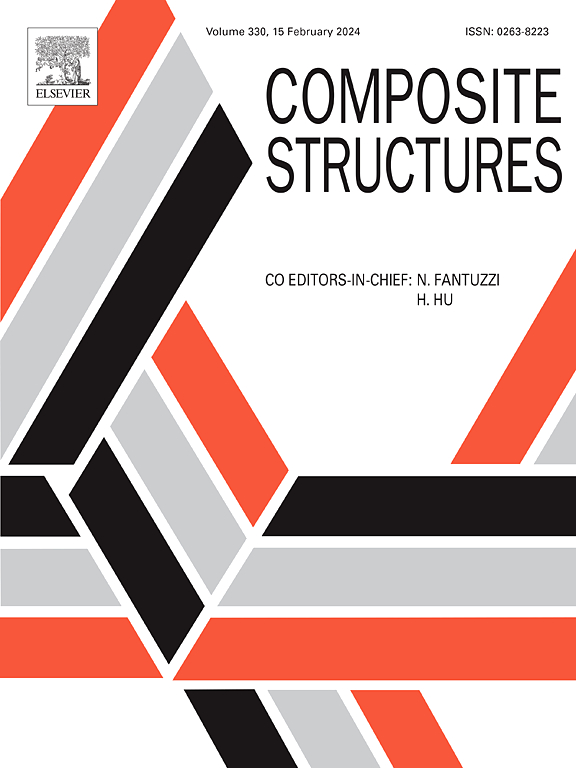金属-离子桥联改性芳纶的防弹和阻燃绝缘性能研究
IF 6.3
2区 材料科学
Q1 MATERIALS SCIENCE, COMPOSITES
引用次数: 0
摘要
通过宏观接枝行为与微观桥接结构的演变相结合,研究了MPP-Cu-MAF的基本力学性能、抗冲击性能、阻燃性能和保温性能。此外,还分析了MPP-Cu-MAF织物复合材料的抗冲击、阻燃和保温机理。表征实验揭示了金属离子配位和金属离子配位桥接改性前后纤维化学结构的变化。MPP-Cu-MAF的制备成功,保持了原材料晶体结构的完整性。纱线拉出测试表明,与AF相比,MPP-Cu-MAF的抗拉强度提高了3.2倍,摩擦性能也有所改善。弹道试验表明,MPP-Cu-MAF可将AF的弹道极限速度(V50)从51 m/s提高到97 m/s, SEA和η值均有显著提高。多层复合改性纤维材料具有较强的防弹性能。阻燃和隔热实验揭示了这些特性背后的机制,表明MPP-Cu-MAF在这两个方面都优于AF。这些研究结果为MPP-Cu-MAF作为新型防护材料在工程实践中的开发和应用提供了理论支持和实验依据。本文章由计算机程序翻译,如有差异,请以英文原文为准。
Study on ballistic protection and flame retardant insulation properties of modified aramid based on metal-ion bridge linkage
By combining macro grafting behavior with the evolution of micro bridging structure, the study explored the fundamental mechanical properties, impact resistance, flame retardancy, and thermal insulation properties of MPP-Cu-MAF. Additionally, the impact resistance, flame retardancy, and thermal insulation mechanisms of MPP-Cu-MAF fabric composites were analyzed. Characterization experiments revealed changes in the chemical structure of the fiber before and after metal ion coordination and MPP grafting modification using the metal ion coordination bridging method. The successful preparation of MPP-Cu-MAF was confirmed, maintaining the integrity of the original material’s crystal structure. Yarn pull-out tests demonstrated a 3.2-fold increase in tensile strength for MPP-Cu-MAF compared to AF, along with improved friction performance. Ballistic tests indicated that MPP-Cu-MAF could increase the ballistic limit velocity (V50) of AF from 51 m/s to 97 m/s, with significant enhancements in SEA and η values. Multi-layer laminated modified composite fiber materials exhibited strong bulletproof performance. Flame retardancy and thermal insulation experiments revealed the mechanisms behind these properties, showing that MPP-Cu-MAF outperformed AF in both aspects. These findings offer theoretical support and an experimental basis for the development and application of MPP-Cu-MAF as new protective materials in engineering practice.
求助全文
通过发布文献求助,成功后即可免费获取论文全文。
去求助
来源期刊

Composite Structures
工程技术-材料科学:复合
CiteScore
12.00
自引率
12.70%
发文量
1246
审稿时长
78 days
期刊介绍:
The past few decades have seen outstanding advances in the use of composite materials in structural applications. There can be little doubt that, within engineering circles, composites have revolutionised traditional design concepts and made possible an unparalleled range of new and exciting possibilities as viable materials for construction. Composite Structures, an International Journal, disseminates knowledge between users, manufacturers, designers and researchers involved in structures or structural components manufactured using composite materials.
The journal publishes papers which contribute to knowledge in the use of composite materials in engineering structures. Papers deal with design, research and development studies, experimental investigations, theoretical analysis and fabrication techniques relevant to the application of composites in load-bearing components for assemblies, ranging from individual components such as plates and shells to complete composite structures.
 求助内容:
求助内容: 应助结果提醒方式:
应助结果提醒方式:


